Wearable health devices enhance health monitoring and fitness tracking, providing real-time data on heart rate and sleep patterns. Key features include medication reminders and social sharing capabilities. Users should consider accuracy, battery life, compatibility, and comfort when choosing a device. Experiences vary based on features and integration with mobile apps, impacting overall satisfaction and health management.
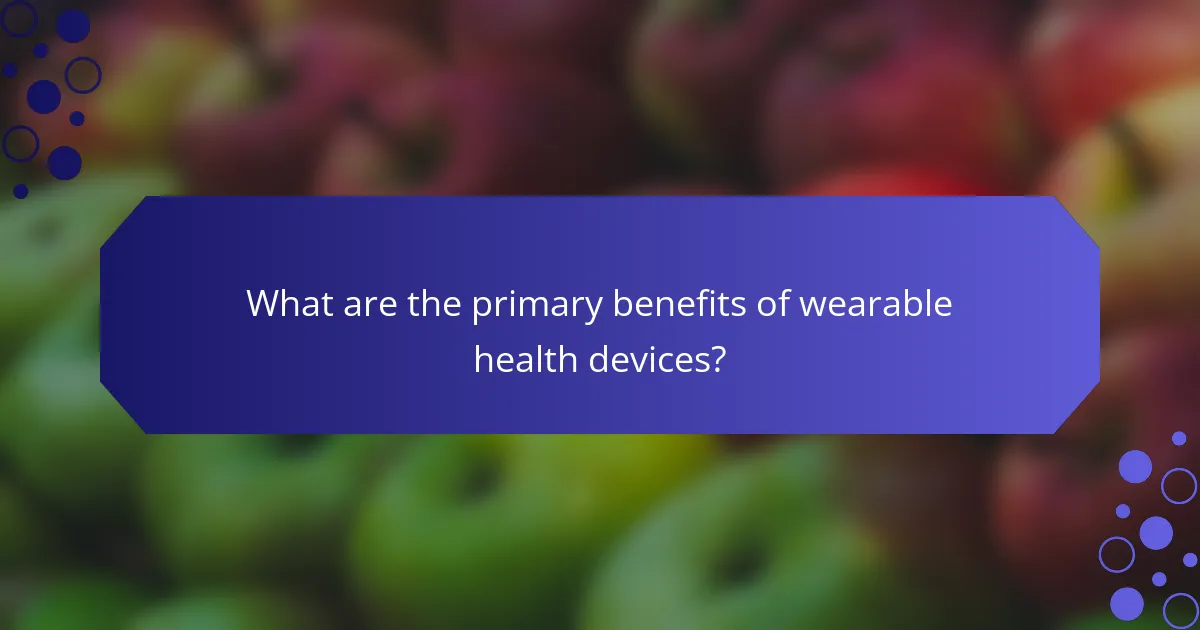
What are the primary benefits of wearable health devices?
Wearable health devices offer numerous benefits, including enhanced health monitoring, improved fitness tracking, and increased motivation for users. They provide real-time data on heart rate, sleep patterns, and physical activity, enabling users to make informed health decisions. Additionally, these devices often include features such as reminders for medication and hydration, which can lead to better overall health management. The integration of social sharing capabilities also fosters a supportive community, encouraging users to stay committed to their health goals.
How do wearable health devices enhance fitness tracking?
Wearable health devices enhance fitness tracking by providing real-time data, personalized insights, and motivation. These devices monitor metrics like heart rate, activity levels, and sleep patterns, facilitating informed health decisions. Users can track progress over time, set goals, and receive alerts for inactivity, promoting a more active lifestyle. Unique features, such as GPS tracking and integration with mobile apps, further enrich user experiences, making fitness tracking more effective and engaging.
What role do wearable health devices play in chronic disease management?
Wearable health devices play a crucial role in chronic disease management by providing real-time data and monitoring. These devices track vital signs, activity levels, and medication adherence, enabling proactive health interventions. They empower patients by promoting self-management and improving communication with healthcare providers. Research indicates that using wearable devices can lead to better health outcomes and increased patient engagement.
How can wearable health devices improve mental well-being?
Wearable health devices can significantly enhance mental well-being by providing real-time feedback and encouraging healthy habits. These devices often track physiological metrics like heart rate and sleep patterns, helping users identify stress triggers and improve sleep quality.
Additionally, features such as guided breathing exercises and mindfulness reminders promote relaxation and reduce anxiety. User experiences indicate that consistent use fosters a sense of accountability and motivation, leading to better mental health outcomes. The integration of social sharing capabilities further enhances engagement, allowing users to connect with supportive communities.
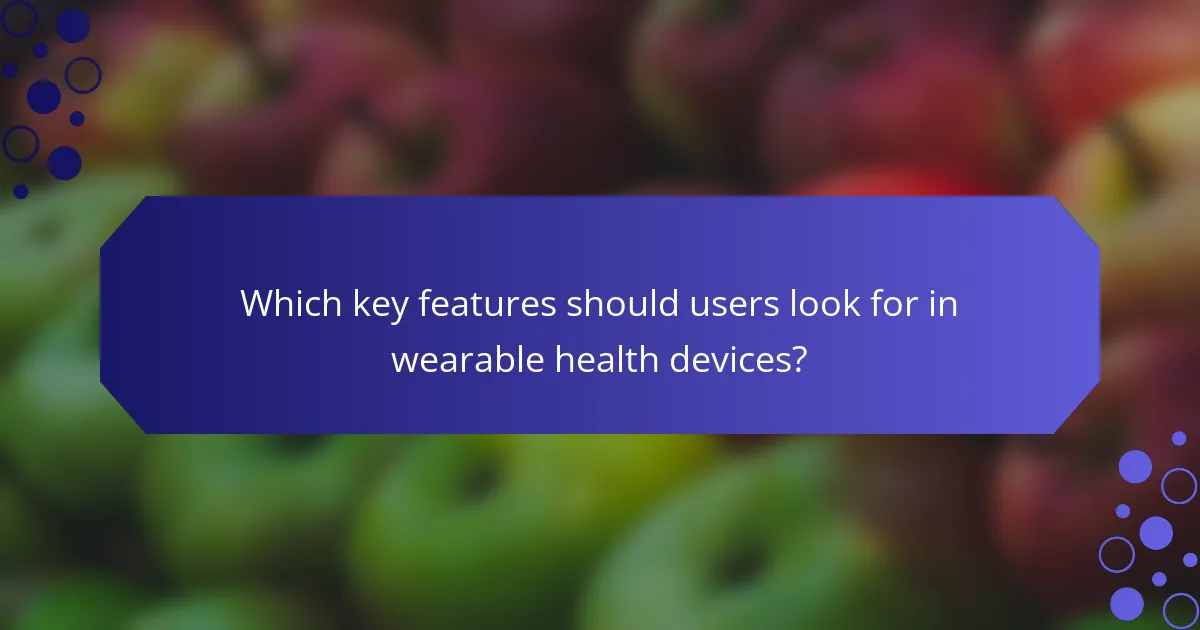
Which key features should users look for in wearable health devices?
Users should look for accuracy, battery life, compatibility, comfort, data security, and user-friendly interfaces in wearable health devices.
Accuracy is crucial for reliable health monitoring. Battery life impacts usability, with longer durations enhancing convenience. Compatibility with smartphones and apps ensures seamless integration. Comfort affects daily wearability, while data security protects sensitive health information. A user-friendly interface simplifies navigation and enhances the overall experience.
What types of sensors are commonly found in wearable health devices?
Wearable health devices commonly include sensors such as heart rate monitors, accelerometers, gyroscopes, and temperature sensors. These sensors track vital health metrics and physical activity levels, enhancing user health management. Heart rate monitors measure pulse rates, while accelerometers detect movement patterns. Gyroscopes provide orientation data, and temperature sensors monitor body temperature, contributing to comprehensive health insights.
How does battery life impact the usability of wearable health devices?
Battery life significantly influences the usability of wearable health devices by determining their operational duration. Longer battery life enhances user experience by reducing the frequency of recharging, allowing continuous health monitoring. Devices with shorter battery life may disrupt usage patterns, leading to missed data and decreased reliability. For instance, a device with a battery life of 7 days supports uninterrupted tracking, while one lasting only 24 hours may hinder consistent use. Users prefer devices that combine functionality with extended battery performance, as it directly affects their engagement and satisfaction.
What connectivity options are essential for optimal performance?
Optimal performance of wearable health devices relies on several essential connectivity options. These include Bluetooth for short-range communication, Wi-Fi for internet access, and NFC for quick data transfer. Each option enhances functionality, enabling real-time health monitoring and data synchronization with mobile applications. As a result, users experience seamless integration with their digital health ecosystem.
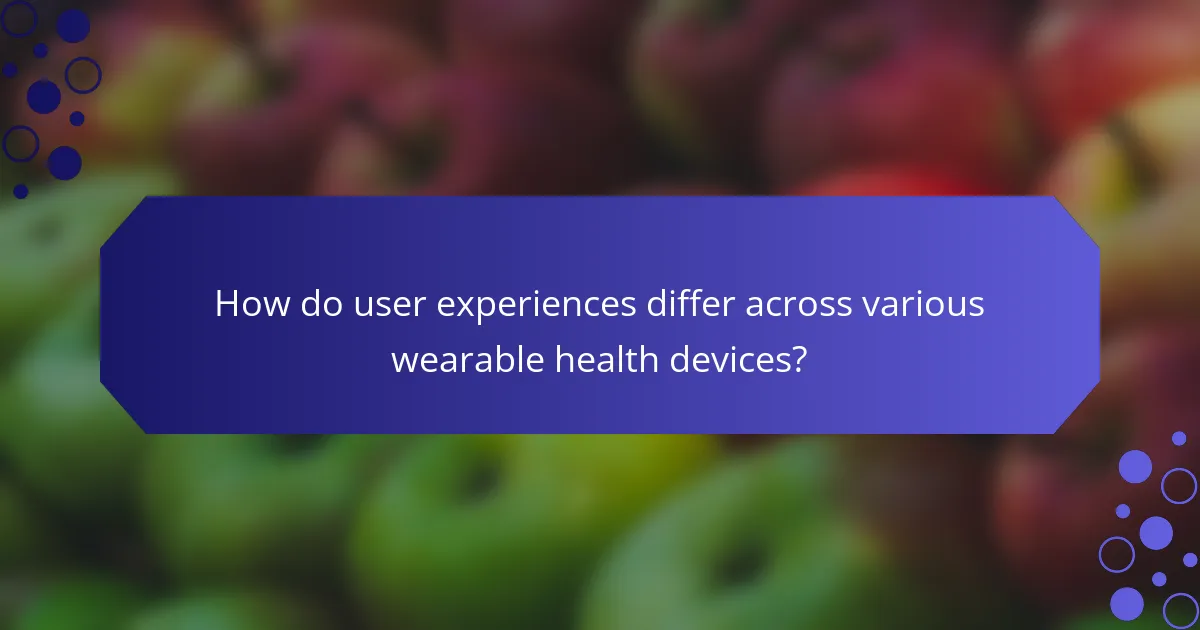
How do user experiences differ across various wearable health devices?
User experiences vary significantly across wearable health devices due to differences in features, usability, and integration. Devices like smartwatches offer comprehensive health tracking, while fitness bands focus on specific metrics. User interface design impacts ease of use, influencing overall satisfaction. Integration with mobile apps enhances functionality, providing personalized insights. Battery life also plays a critical role, affecting how often users need to recharge.
What are common user challenges with wearable health devices?
Common challenges with wearable health devices include battery life, accuracy of health data, comfort during prolonged use, and connectivity issues with smartphones. Users often report difficulties in navigating apps and syncing data, which can hinder the overall experience. Additionally, some devices may lack customization options, limiting their effectiveness for individual health needs.
How do user demographics influence the choice of wearable health devices?
User demographics significantly influence the choice of wearable health devices. Factors such as age, gender, income, and lifestyle preferences shape consumer behavior and device selection.
Younger users tend to prefer devices with advanced features, such as fitness tracking and social connectivity. In contrast, older adults often prioritize simplicity and health monitoring functions. Gender differences also play a role; women may seek devices that emphasize wellness and aesthetics, while men might focus on performance metrics.
Income levels affect accessibility to high-end devices with more features. Health-conscious individuals are more likely to invest in wearables that provide comprehensive health data. As a result, manufacturers tailor their products to meet the specific needs of diverse demographic groups, enhancing user experience and satisfaction.
What feedback do users provide about device accuracy and reliability?
Users generally report that wearable health devices demonstrate high accuracy and reliability. Many devices effectively track vital metrics such as heart rate and sleep patterns, often achieving over 90% accuracy in clinical comparisons. However, some users highlight occasional discrepancies, particularly in activity tracking, where environmental factors may influence results. Overall, consistent software updates and user-friendly interfaces contribute to positive user experiences, enhancing trust in these devices.
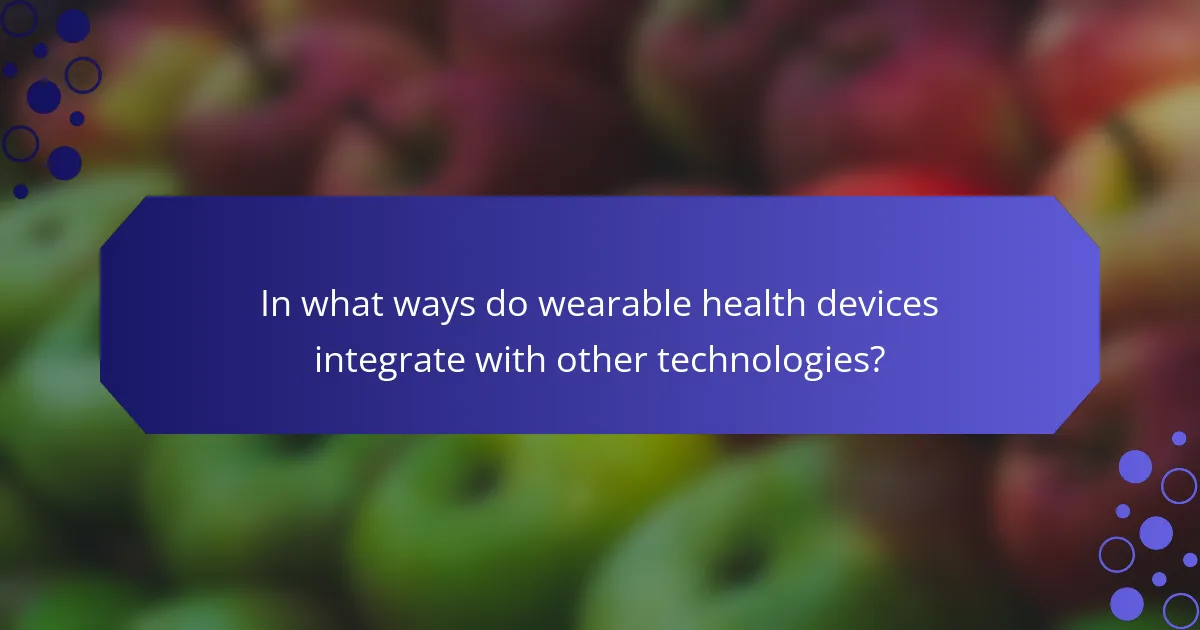
In what ways do wearable health devices integrate with other technologies?
Wearable health devices integrate with other technologies primarily through data sharing, connectivity, and interoperability. They often sync with smartphones, cloud services, and health management platforms to enhance user experience and health monitoring.
For example, many wearable devices connect via Bluetooth to smartphones, allowing users to track fitness metrics and receive notifications. This integration enables real-time health data analysis and personalized recommendations.
Additionally, wearables can interact with smart home devices, providing a comprehensive health ecosystem. Users can automate health-related tasks, such as adjusting lighting for better sleep based on sleep tracking data.
The integration of wearable health devices with telehealth platforms is another significant advancement. This allows healthcare providers to monitor patients remotely, improving health outcomes and patient engagement.
How do wearable health devices sync with mobile applications?
Wearable health devices sync with mobile applications via Bluetooth technology. This connection allows for real-time data transfer, enabling users to monitor health metrics conveniently. The synchronization process typically involves pairing the device with the app, which may require user authentication. Once connected, data such as heart rate, activity levels, and sleep patterns are shared, enhancing user experiences and providing valuable insights. This integration supports personalized health management, making it easier to track progress and set goals.
What role do cloud services play in enhancing wearable device functionality?
Cloud services significantly enhance wearable device functionality by providing real-time data processing, storage, and analytics capabilities. They enable seamless synchronization of health metrics across devices, improving user experience and health monitoring accuracy.
Cloud platforms facilitate the integration of artificial intelligence, allowing for personalized health insights based on user data. This capability transforms raw data into actionable recommendations, enhancing the overall effectiveness of wearable health devices.
Additionally, cloud services ensure data security and privacy through advanced encryption protocols, fostering user trust in wearable technology. This is crucial as health data sensitivity requires robust protection measures.
In summary, the synergy between cloud services and wearable health devices amplifies their capabilities, leading to improved health outcomes and user satisfaction.
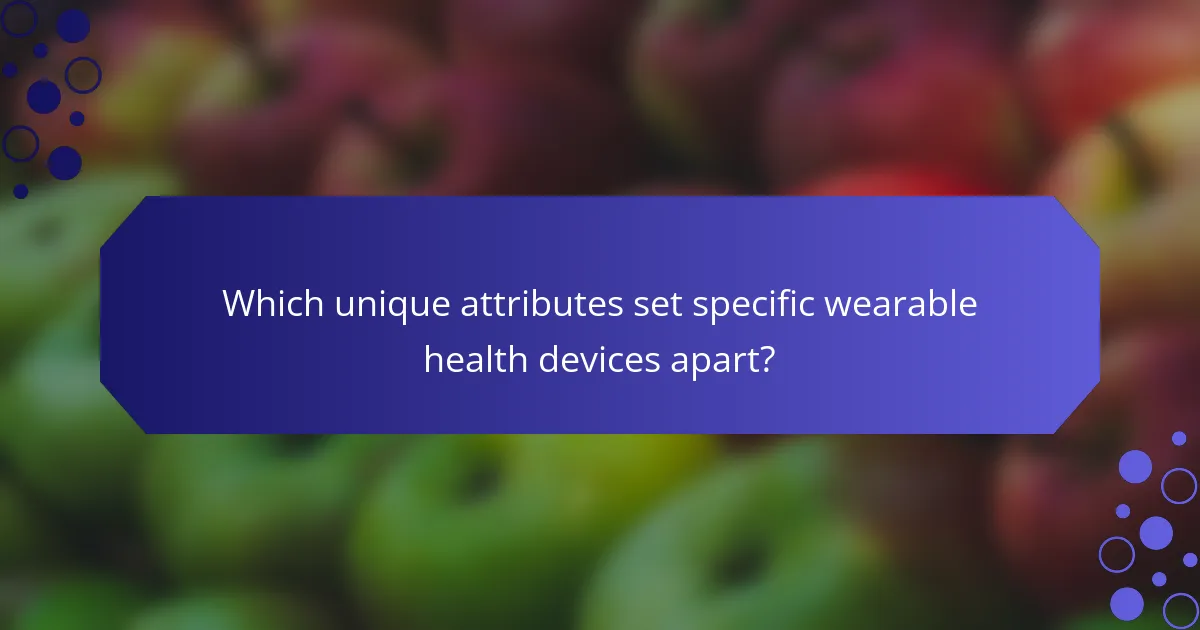
Which unique attributes set specific wearable health devices apart?
Unique attributes that set wearable health devices apart include advanced biometric sensors, personalized health insights, and integration with smart home ecosystems. These devices often feature unique designs tailored for specific activities, such as sleep tracking or fitness monitoring. Additionally, some models provide rare attributes like stress management algorithms or hydration reminders, enhancing user experience and engagement. These distinctions contribute to a more personalized approach to health management.
What innovative features are found in premium wearable health devices?
Premium wearable health devices feature advanced capabilities such as continuous health monitoring, personalized fitness coaching, and integrated health data analytics. These innovations enhance user experience and provide actionable insights.
Key features include:
– Heart rate monitoring with real-time alerts
– Sleep tracking with detailed analysis
– Blood oxygen level measurement
– Stress management tools
– GPS tracking for outdoor activities
– Water resistance for various environments
These attributes contribute to a comprehensive health management system, promoting user engagement and encouraging healthier lifestyles.
How do specialized devices cater to niche markets or specific health needs?
Specialized devices effectively address niche markets and specific health needs by offering tailored functionalities. These wearable health devices provide unique features such as continuous glucose monitoring for diabetics or heart rate tracking for athletes. They enhance user experience by delivering real-time data, improving health management, and promoting proactive care. As a result, users can make informed decisions based on precise metrics, ultimately catering to diverse health requirements.
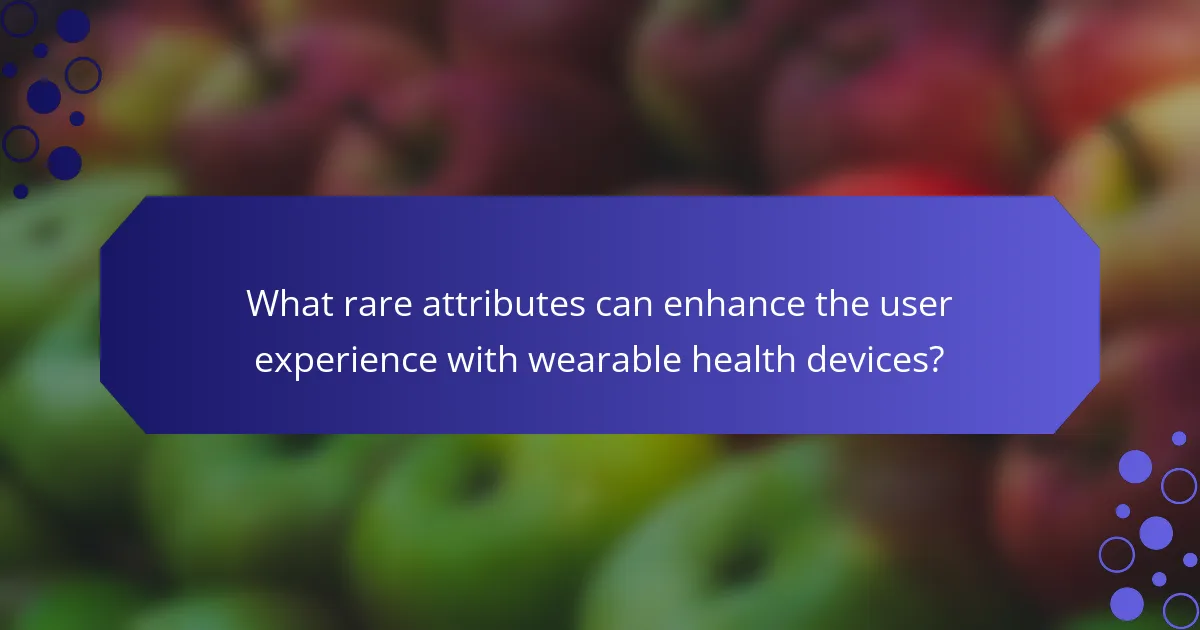
What rare attributes can enhance the user experience with wearable health devices?
Rare attributes that can enhance user experience with wearable health devices include advanced biometric sensors, personalized health insights, and real-time environmental monitoring. These features provide users with unique data, improving overall health management. For instance, devices with advanced sleep tracking can offer tailored recommendations based on individual sleep patterns. Additionally, seamless integration with smart home systems can create a more cohesive health management experience.
How do limited-edition devices offer unique functionalities?
Limited-edition wearable health devices provide unique functionalities through exclusive features and design elements. These devices often incorporate advanced sensors and algorithms that enhance health monitoring capabilities. For example, some may include unique stress management tools or specialized fitness tracking modes not available in standard models. Additionally, limited editions often cater to niche user preferences, such as aesthetics or specific health concerns, creating a personalized experience. This combination of distinct features and user-focused design makes limited-edition devices particularly appealing to health-conscious consumers.
What emerging technologies are being integrated into wearable health devices?
Wearable health devices are increasingly integrating technologies such as artificial intelligence, biometric sensors, and connectivity features. These advancements enhance user experience by providing real-time health monitoring and personalized insights. For example, AI algorithms analyze data from biometric sensors to predict health trends, improving preventative care. Additionally, the integration of 5G connectivity allows for faster data transmission, enabling seamless interaction with healthcare providers. These technologies represent a unique attribute of modern wearable devices, setting them apart in the health tech landscape.
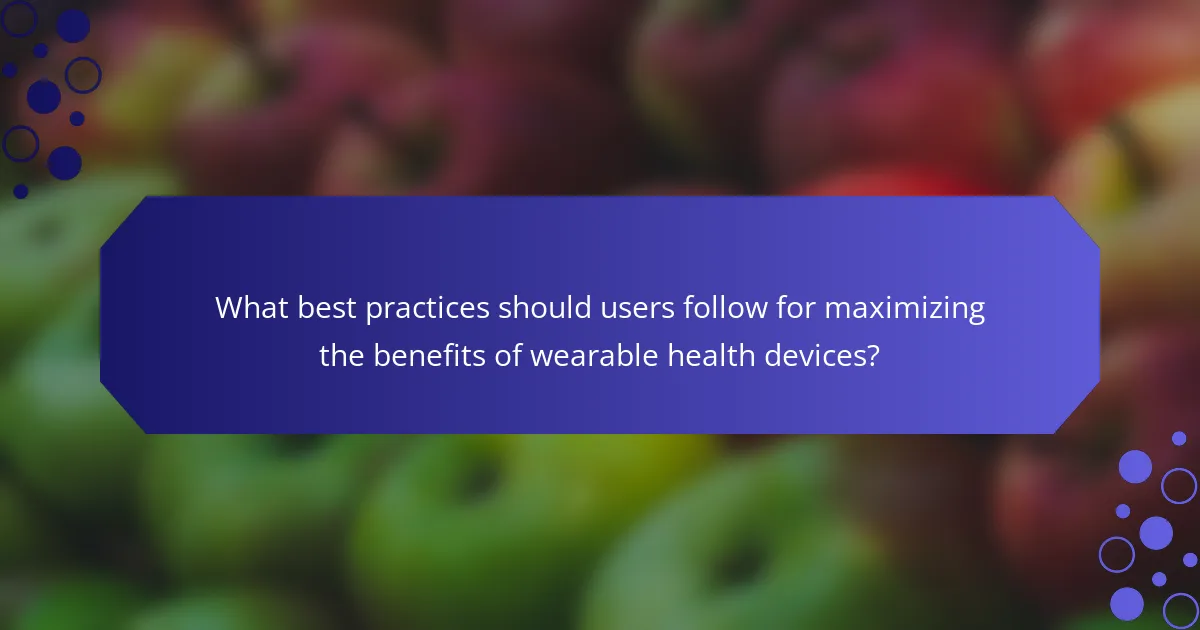
What best practices should users follow for maximizing the benefits of wearable health devices?
To maximize the benefits of wearable health devices, users should follow these best practices:
1. Regularly update device firmware to access new features and security enhancements.
2. Set specific health goals and track progress consistently for motivation.
3. Sync data with health apps for comprehensive insights and analytics.
4. Wear the device consistently to gather accurate health metrics.
5. Engage with community features for support and shared experiences.
6. Maintain battery health by following charging guidelines to ensure optimal performance.
